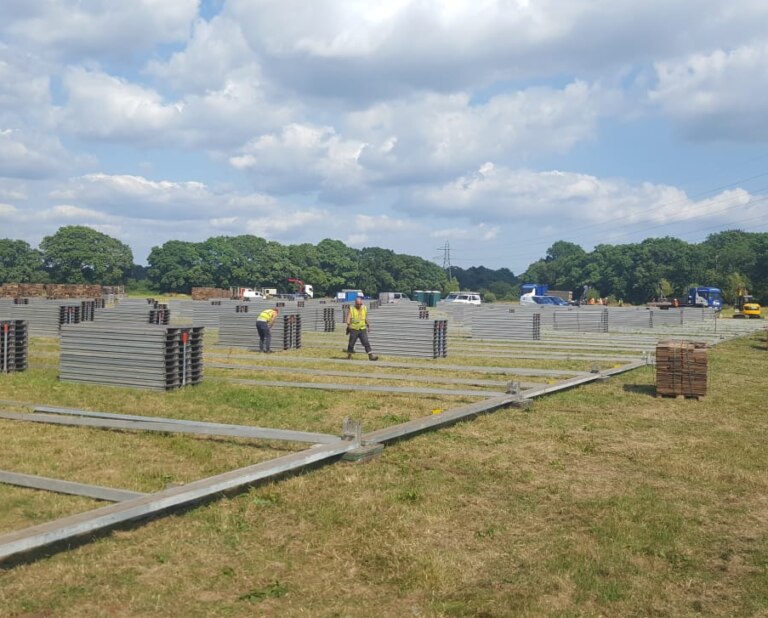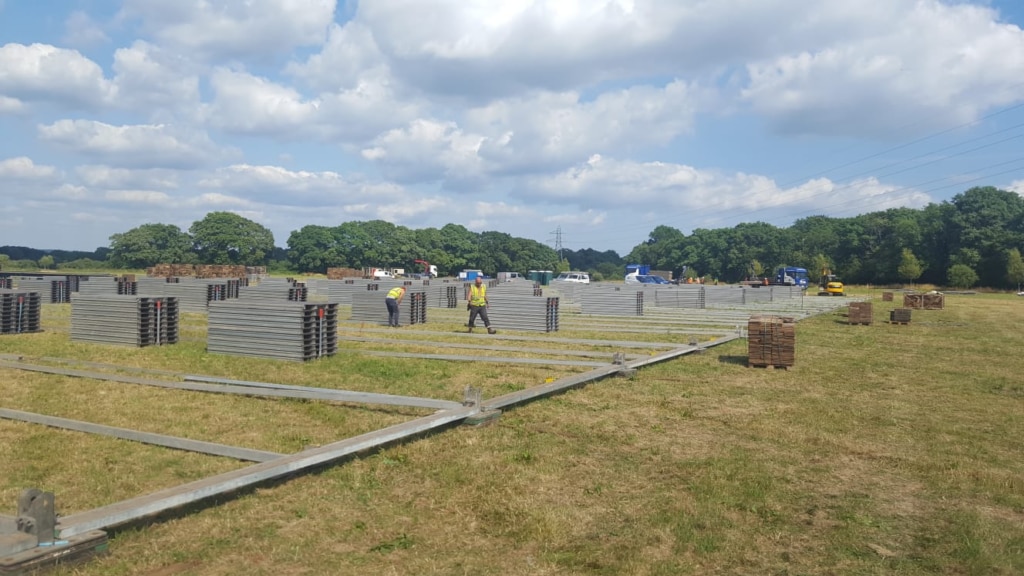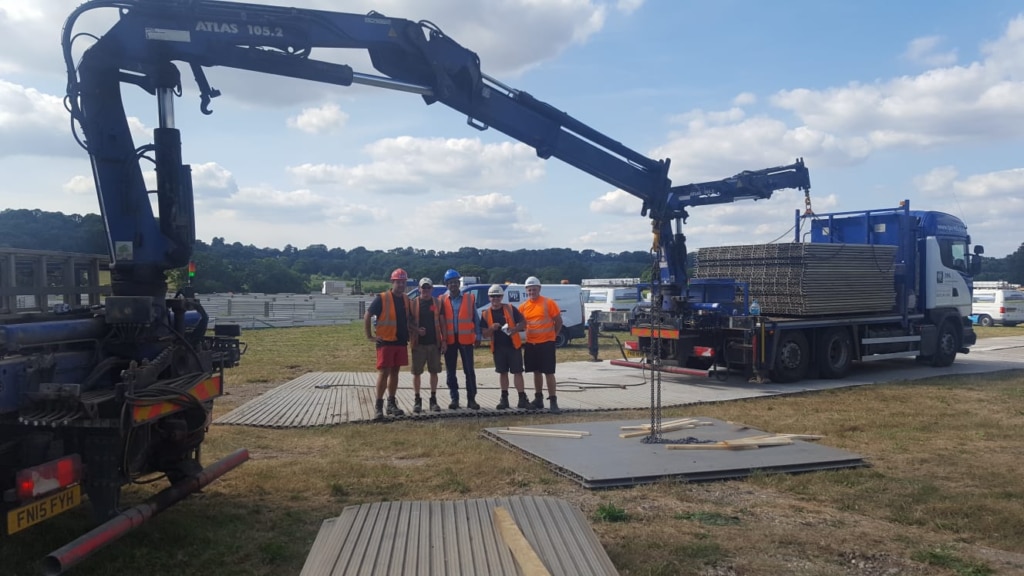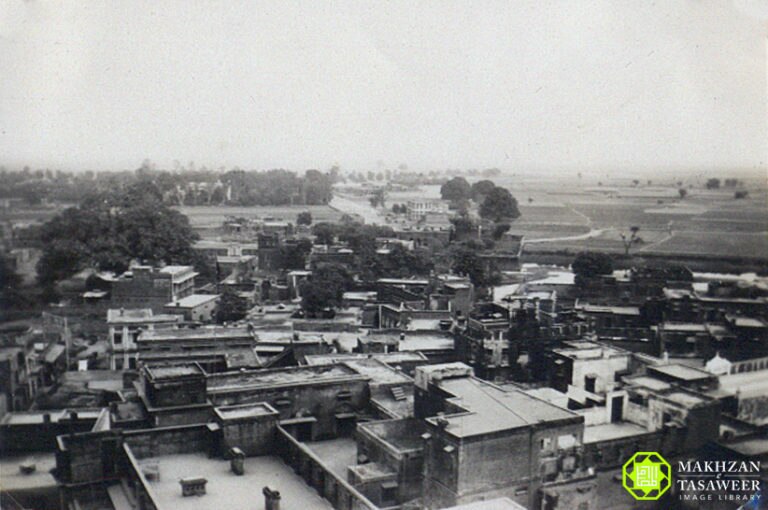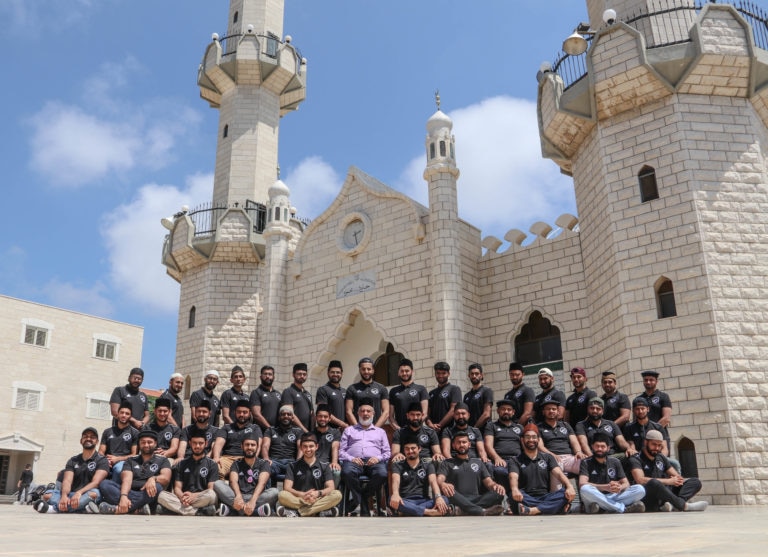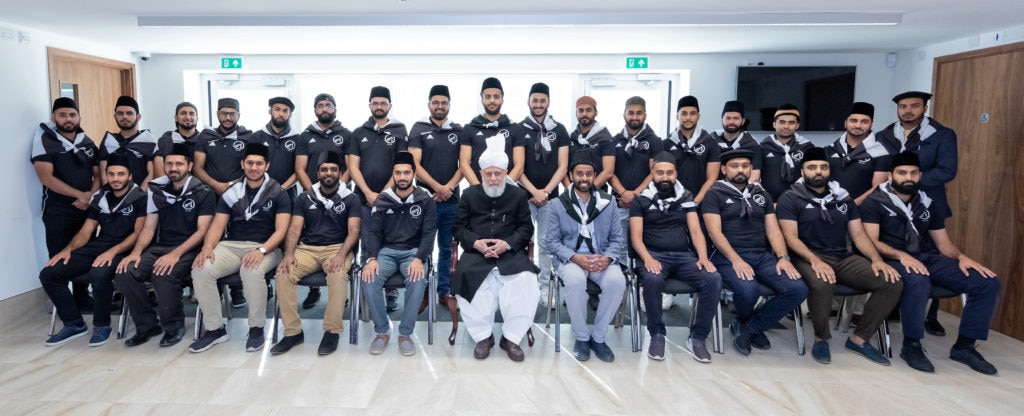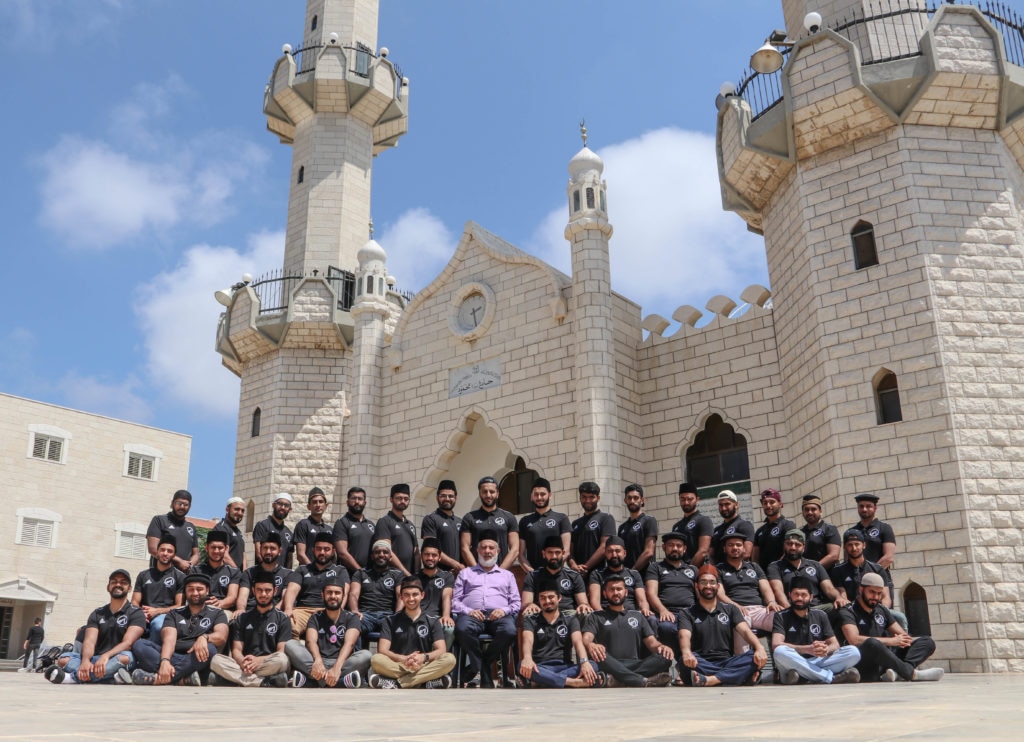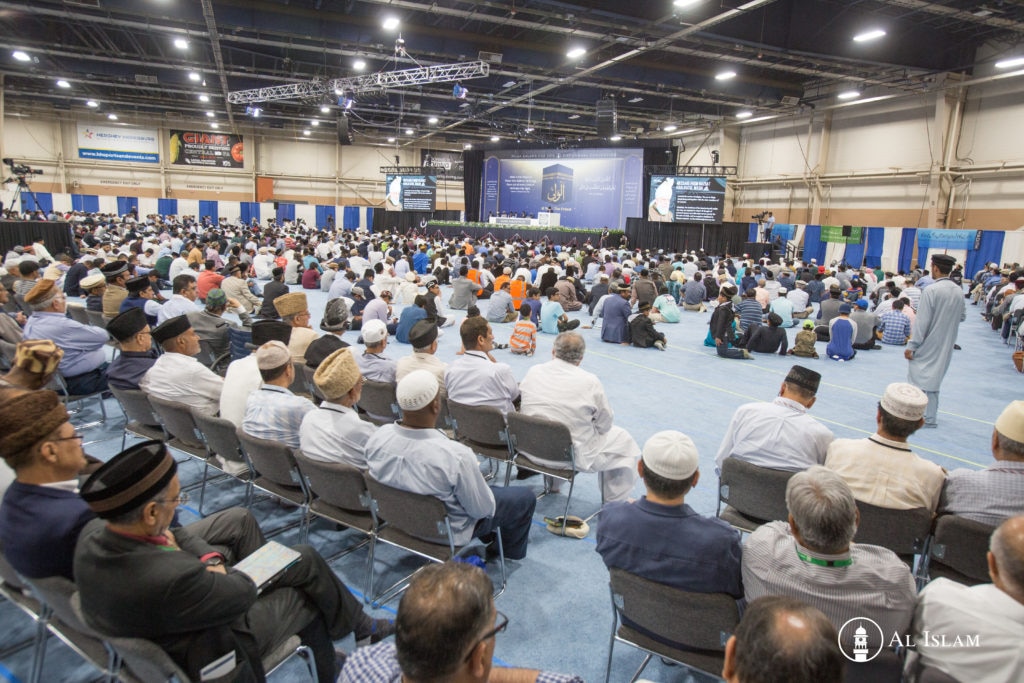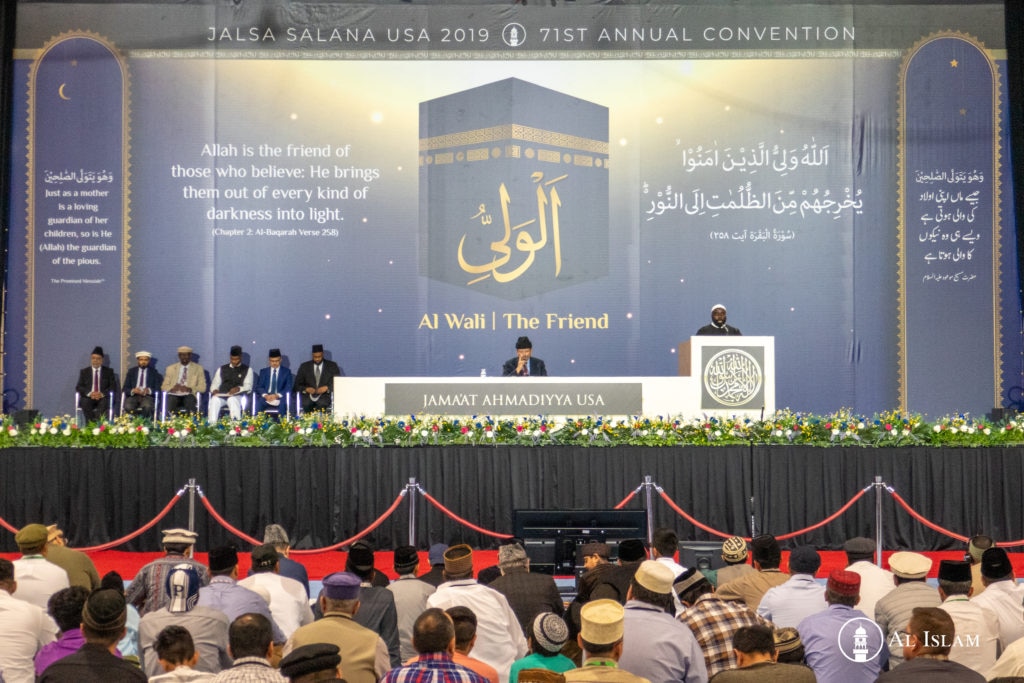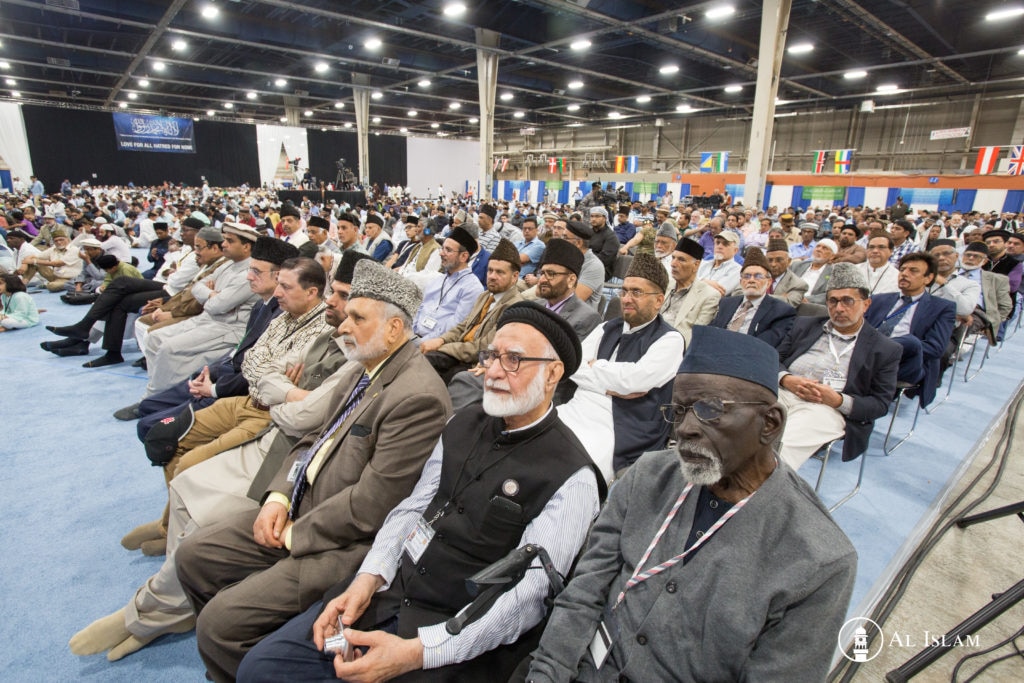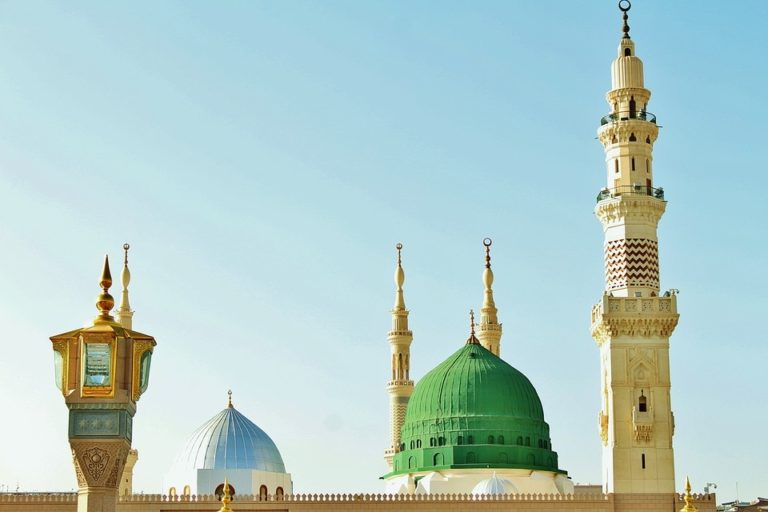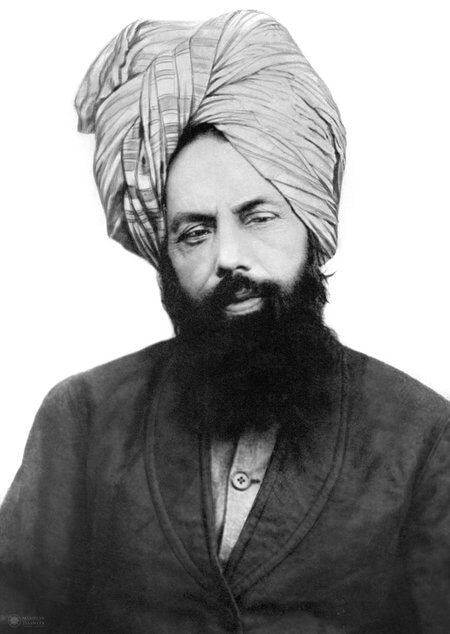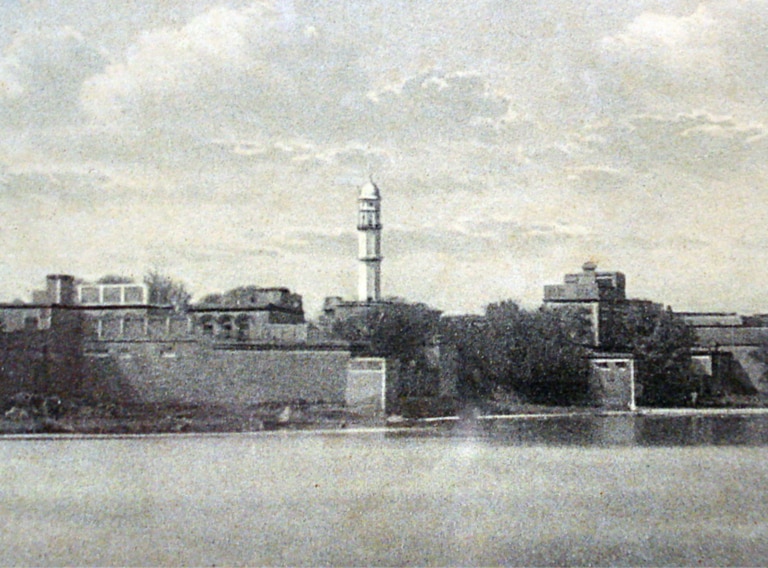Prime minister visits exhibitions, takes part in MTA discussion and addresses gathering at convention
Mukarram Nazeer, Canada Correspondent

The 43rd Jalsa Salana Canada was held on 5-7 July 2019 at the International Centre, Mississauga, Ontario, where thousands of devoted members of Jamaat-e-Ahmadiyya Canada, USA and other parts of the world joined to become recipients of the prayers of the Promised Messiahas.
One aspect that made this year’s Jalsa Salana Canada unique was the attendance of the Canadian Prime Minister, Justin Trudeau, who visited on the last day.
Speaking to Al Hakam about the attendance of the Canadian prime minister at Jalsa Salana, Asif Khan Sahib, Secretary External Affairs said:
“About four years ago, the prime minister had promised to return as the prime minister. This was the last year for him to potentially keep this promise as the election is coming up in October.”
Explaining the purpose of his visit, Asif Khan Sahib said:
“The purpose of the visit was to mainly address the audience and, of course, to pay tribute to the efforts of the Jamaat. As well as speaking to the gathering, the prime minister was shown various exhibitions, for example Humanity First, the Quran exhibition, Muslims for Remembrance and the Pathway to Peace exhibition. He also met with members of the national amila and Lajna media team members.
“The prime minister arrived at around 2:30pm and spent almost 3 hours with us. Before taking to the stage, he was invited to the MTA International studios where I conducted a short discussion with him.”

During the discussion for MTA, whilst discussing unity, the prime minister said:
“It is easy to scare people, it is easy to divide people; it is harder to bring people together. Only when all of us, who believe in a better future, stand strongly together, will we be able to build that better future.”
Regarding his thoughts and views on Hazrat Khalifatul Masih Vaa, he said:
“Your leadership, as I told, His Holiness, is really important in this world at this time … Having had the opportunity to sit down a few times now with His Holiness and to hear his deep commitment to the world, not just to the Ahmadiyya Community, but to seeing more peace and more openness and more love throughout the world is truly astonishing and encouraging.

“This Ahmadiyya message of ‘Love for all, hatred for none’ is one of those things that we need a lot more of in the world. And his efforts, whether it’s reaching out to global leadership, or inspiring and challenging Ahmadiyya Muslims to keep stepping up and keep pushing to respond when communities are facing hardship, when there are disasters or incidents or when people just take note of, in their everyday lives, trying to be positive forces and positive actors in their communities. That is an important thing and it’s a difficult message to be leading with in the world today … The work His Holiness is doing, and indeed the entire Ahmadiyya Community, is an inspiration to us all.”
When asked about his message for the youth, the prime minister said:
“I think one of the things that we’ve seen around the world is a sort of disengagement; a cynicism or a skepticism about not just politics, but about our institutions and their ability to solve some of the challenges that people are facing … Be involved in your community, be involved in politics, be involved in various initiatives that you feel can make a difference in the world …

“It’s very easy for individuals, particularly young people, to say, ‘But I’m only one voice. What can I do to change my community?’ Well, the opportunities to step up, the opportunities to make a difference are absolutely essential and they are there. So, anything I can do to encourage more people to look at the world around them and see how they can help, how they can serve, how they can build a better future in an active way, regardless of your age, regardless of your background, it makes it easier for all of us to succeed.”
The prime minister also spoke about the persecution of Ahmadis, and while addressing religiously persecuted members of the Jamaat, he said:
“My message is to stay strong and rooted in faith and in the conviction that the world is filled with goodness and we need to continue to contribute to it and we need to continue to build towards it.”
Speaking about the significance of the prime minister’s visit and what he had to say to the Canadian Jamaat, Asif Khan Sahib said:
“I feel it speaks volumes that the prime minister actively participated in Jalsa Salana in this way. He simply could have said that he would only address the audience. However, when informed of the various exhibitions, he keenly expressed his desire to view them. He was particularly impressed by the bullet points mentioned in the Pathway to Peace exhibition and said that he was very much looking forward to reading the book World Crisis and the Pathway to Peace.”
The first day of this year’s Jalsa started on Friday, 5 July with the recording of the Friday Sermon delivered by Hazrat Khalifatul Masih Vaa at Jalsa Salana Germany. A brief Friday Sermon was then delivered locally by Naib Amir, Hadi Ali Chaudhry Sahib followed by Jumuah prayers. Lunch was served to all guests of the Promised Messiahas.
An interactive session with various media representatives during a press conference was a key highlight of the day. Additional Nazir Islah-o-Irshad & Dawat Ilallah and Mufti-e-Silsila Ahmadiyya, Mubashar Ahmad Kahlon Sahib, along with National Amir Canada, Lal Khan Malik Sahib, answered questions presented by media representatives.
Just outside the men’s hall in the plus 30 degree Celsius summer heat of July, Liwa-e-Ahmadiyyat was raised beside the Canadian flag. Silent prayer was led by Markaz Representative, Mubashar Ahmad Kahlon Sahib.
Back inside, the air-conditioning provided relief to the audience who listened to the recitation of the Holy Quran with translation, which signalled the start of the First Session. Three Khuddam presented a beautiful and harmonious tarana (choral poem) on Khilafat. National Amir Jamaat Canada, Lal Khan Malik Sahib spoke to the attendees on “Turning Fear into Peace”, which was delivered in both English and Urdu.
A beautiful poem with English translation came next followed by an interesting English speech on “Islam: The True Defender of Women’s Rights” delivered by Missionary Vaughan, Imtiaz Ahmad Sra Sahib.
Some announcements and a dinner wrapped up the first session of Jalsa Salana Canada. Jamaat members socialised and enjoyed food, tea, the Bazaar, the bookstore and a exhibition. Volunteers provided excellent assistance in security, parking, first aid, translation, transportation, food preparation, registration, water supply and many more departments.
All the Greater Toronto Area mosques and Salat centres held daily congregational Maghrib and Isha prayers for all members.
In the darkness of another warm summer morning, pre-dawn Tahajud and Fajr prayers followed by dars were held at all mosques and Salat centres around the Greater Toronto Area.
The Second Session of Jalsa Salana Canada started with the recitation of the Holy Quran and translation. A comforting poem with translation was presented before a presentation on “Faith Inspiring Stories of Ahmadi Martyrs in the Era of Hazrat Khalifatul-Masih II, may Allah be pleased with him” by Mohtamim Umur-e-Tulaba, Majlis Khuddam-ul-Ahmadiyya Canada, Ahmed Bazid Sahi Sahib.
Missionary Peace Village, Attaul Mannan Sahib explained how to give priority to faith over worldly things in his speech, “Experiencing God in a Materialistic World”.
The annual award of Alam-e-Inami Majlis Ansarullah Canada was presented to Emery Village Weston Region. Majlis Khuddam-ul-Ahmadiyya Scarborough South was recognised with the Alam-e-Inami Majlis Khuddam-ul-Ahmadiyya Canada and Majlis Atfal-ul-Ahmadiyya Saskatoon North took the top prize of “Alam-e-Inami Majlis Atfal-ul-Ahmadiyya Canada”.
Various high achieving students received academic achievement awards followed by awards to four dedicated young Huffaz (sing. Hafiz – person who commits the entire Quran to memory) who graduated from the Hifz-ul-Quran School Canada, memorising the entire Quran in a total period between 2-4 years.
Winners of Alam-e-Inami Majlis Ansarullah Canada, Emery Village Weston Region
Winners of Alam-e-Inami Majlis Khuddam-ul-Ahmadiyya Canada, Scarborough South Region
Over 6,000 kilometres away at Jalsa Salana Germany, Hazrat Khalifatul Masih V, may Allah strengthen his hand, had addressed the ladies and the recording of that address was shown at Jalsa Salana Canada. Traditional announcements and lunch service for all attendees brought the Second Session to a close.
After congregational Zuhr and Asr prayers at the Jalsa Gah, the Third Session of Jalsa Salana Canad initiated with the recitation of the Holy Quran, followed by a beautiful poem with translation. Mubashar Ahmad Kahlon Sahib of Rabwah delivered a heart-warming speech titled, “Goodness Lies in Coming Unto Me With Sincerity”.
A well known and respected former Federal Cabinet member and former Minister of Foreign Affairs, Mr Lloyd Axworthy was the recipient of the 8th Annual Sir Muhammad Zafrulla Khan Award for Distinguished Public Service.
The programme shifted focus back to Germany with the recorded address of Hazrat Khalifatul Masih Vaa to the German Guests at Jalsa Salana Germany earlier that day.
After the speech, many familiar faces among the distinguished guests were invited to the stage to present some personal thoughts on Jamaat-e-Ahmadiyya Canada. The Prime Minister of Canada, Mr Justin Trudeau was among the many friends of the Canadian Jamaat who spoke from the podium.
Various announcements concluded the Third Session and Jamaat members along with guests made their way to the food area to benefit from the Langar Khana of the Promised Messiahas. Many members left the Jalsa Gah and quickly gathered for congregational Maghrib and Isha prayers at nearby mosques and Salat centres to add to the spiritual blessings of the day.
Many members also woke up early on the warm, pre-dawn morning to offer Tahajud and Fajr prayers and listen to a dars at one of the many mosques and Salat centres around the Greater Toronto Area.
It was an early start to Day 3 of Jalsa Salana Canada as the Fourth and Final Session began with a traditional breakfast service at the Jalsa Gah. Thousands of members and guests prepared for the live broadcast of the International Ba‘iat ceremony with Hazrat Amirul Momineen, Khalifatul Masih Vaa from Jalsa Salana Germany. The audience at both Jalsas repeated the words of Ba’ait after Huzooraa in unison. A powerful concluding address was then delivered by Syedna Hazrat Khalifatul Masih Vaa to conclude both Jalsas at the same time.
Many members embraced each other and gave thanks for another successful Jalsa Salana in both countries.
The final lunch of Jalsa Salana Canada was followed by congregational Zuhr and Asr prayers. Huzooraa announced the total Jalsa Salana Canada attendance as 18,572, which included 900 guests and over 1000 Jamaat volunteers, by the grace and blessings of Allah.

